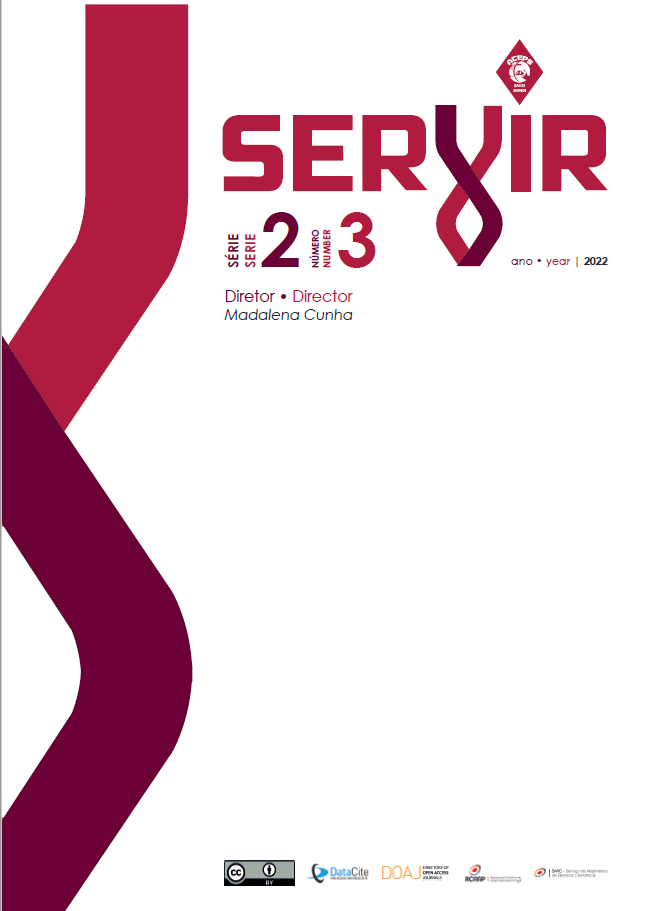Flow characterization intra-hospital medical emergency team activation
DOI:
https://doi.org/10.48492/servir0203.27555Keywords:
In-hospital emergency team, activation flowAbstract
Introduction: In-hospital emergency teams have as their main objective the approach to situations of acute deterioration of the general condition of the patient’s.
Objective: Knowing the contexts of the activation flow path, from the initial process to the patient’s destination, in a northern local health unit.
Methods: Quantitative, exploratory, cross-sectional, descriptive study, based on the analysis of the flow of activations. The sample consists of 78 activation events, that is, we access the data set inserted in the document, after this number of patient mobilization.
Results: The sample is mostly made up of female patient (56.4%), with an average age of 70.85 years. The service that most activated the inhospital medical emergency team was internal medicine (26.9%), with cardiorespiratory arrest being the most frequent reason for activation (28.2%). The main destination of patient was the emergency department (26.2%) and the emergency room (23.1%).
Conclusion: The most prevalent cause for activation of the in-hospital medical emergency team is cardiac arrest. The internal medicine service was responsible for most of the activations. Patient with greater clinical deterioration were referred to the emergency department and emergency room.
Downloads
References
Barbosa, V., Gomes, E., Vaz, S., Azevedo, G., Fernandes, G., Ferreira, A., & Araujo, R. (2016). Falha na ativação da equipe de emergência intra-hospitalar: Causas e consequências. Revista Brasileira de Terapia Intensiva, 28, 420–426.
https://doi.org/10.5935/0103-507X.20160075
Cardo, M. J. (2017). Equipa de emergência intra-hospitalar: Análise das ativações e da perceção da sua importância pelos enfermeiros. (Dissertação de Mestrado), Escola Superior de Saúde de Leiria, Leiria.https://iconline.ipleiria.pt/ handle/10400.8/2987
Courtenay, M., Nancarrow, S., & Dawson, D. (2013). Interprofessional teamwork in the trauma setting: a scoping review. Hum Resour Health, 11, 57. doi:10.1186/1478-4491-11-57 DGS. (2010). Circular Normativa no 15/DQS/DQCO de 22/06/2010. https://www.dgs.pt/directrizes-da-dgs/normas-ecirculares-normativas/circular-normativa-n-15dqsdqco-de-22062010.aspx
Eric J. Lavonas, M., MS; David J. Magid, MD, MPH; Khalid Aziz, MBBS, BA, MA, MEd(IT); Katherine M. Berg, MD; Adam Cheng, MD; Amber V. Hoover, RN, MSN; Melissa Mahgoub, PhD; Ashish R. Panchal, MD, PhD; Amber J. Rodriguez,
PhD; Alexis A. Topjian, MD, MSCE; Comilla Sasson, MD, PhD (2020). Destaques das Diretrizes de RCP e ACE de 2020 da American Heart Association - Edição em português por H.P. Guimarães, MD, PhD, FAHA (2020). In. Etter, R., Takala, J., & Merz, T. M. (2014). Intensive care without walls – introduction of a Medical Emergency Team system in a Swiss tertiary care centre. Swiss Med Wkly, 144, w14027. doi:10.4414/smw.2014.14027
Flórido, T. J. S. (2014). Respostas de emergência a pessoa em situação crítica nas enfermarias do hospital: as práticas, os resultados e as opiniões dos enfermeiros. (Dissertação de Mestrado), Escola Superior de Enfermagem de Coimbra, Coimbra. Retrieved from https://repositorio.esenfc.pt/rc/index.php?module=repository&target=list&id_type%255B%255D=7&type_communication1%255B%255D=7
Gabinete do Secretário de Estado Adjunto do Ministro da Saúde. (2015). Despacho n.º 1400-A/2015 | DRE. Diário da República Eletrónico. https://dre.pt/dre/detalhe/despacho/1400-a-2015-66463212
Gabinete do Secretário de Estado Adjunto e da Saúde. (2018). Despacho n.º 9639/2018 DRE. https://dre.pt/dre/detalhe/despacho/9639-2018-116654166
Hillman, K. M., Chen, J., & Jones, D. (2014). Rapid response systems. Med J Aust, 201(9), 519-521. doi:10.5694/mja14.01088
INE (2021). Censos. Retrieved from https://censos.ine.pt/xportal/xmain?xpgid=censos21_main&xpid=CENSOS21&xlang=
INEM. (2020). Manual de Suporte Avançado de Vida. In INEM (Ed.). Retrieved from https://www.inem.pt/wp-content/uploads/2021/02/Manual-Suporte-Avancado-de-Vida-2020.pdf
Organização Mundial Saúde (2016), Esperança de Média de Vida Aumenta Cinco Anos Entre 2000 e 2015 Mas As Desigualdades na Saúde Persistem. Retrieved from https://www.who.int/news/item/19-05-2016-life-expectancyincreased-by-5-years-since-2000-but-health-inequalities-persist
Ordem dos Enfermeiros [OE]. (2017). Transporte da pessoa em situação. Parecer nº 09 / 2017 https://www.ordemenfermeiros.pt/media/8249/parecer_09_2017_mceemc_transportepessoasituacacritica.pdf
Ordem dos Enfermeiros [OE]. (2018). Regulamento nº429/2018 de 16 de julho: Regulamento das Competências Especificas do Enfermeiro Especialista em Enfermagem Médico-Cirúrgica na área de Enfermagem à pessoa em situação crítica.
Silva, R., Saraiva, M., Cardoso, T., & Aragão, I. C. (2016). Medical Emergency Team: How do we play when we stay? Characterization of MET actions at the scene. Scandinavian journal of trauma, resuscitation and emergency medicine, 24(1), 33. DOI: 10.1186/s13049-016-0222-7
Soar, J., Böttiger, B. W., Carli, P., Couper, K., Deakin, C. D., Djärv, T., Nolan, J. P. (2021). European Resuscitation Council Guidelines 2021: Adult advanced life support. Resuscitation, 161, 115-151. doi:10.1016/j.resuscitation.2021.02.010
Winters, B. D., Weaver, S. J., Pfoh, E. R., Yang, T., Pham, J. C., & Dy, S. M. (2013). Rapid-response systems as a patient safety strategy: a systematic review. Ann Intern Med, 158(5 Pt 2), 417-425. doi:10.7326/0003-4819-158-5-201303051-00009
Published
How to Cite
Issue
Section
License
In order to promote the free circulation of knowledge, Servir is open access journal. All its content is available and protected under the Creative Commons license (CC BY 4.0).
The journal allows self-archiving in institutional repositories of all versions, which may become immediately available


